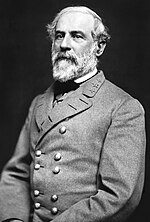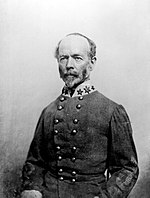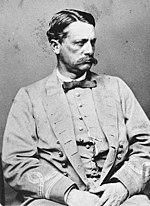The United States (The Union)


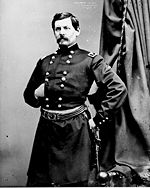
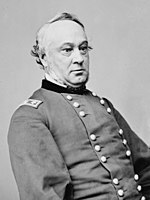

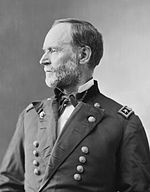



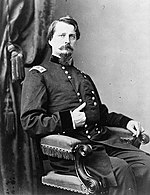


Civilian military leaders
President Abraham Lincoln was Commander-in-Chief of the Union armed forces throughout the conflict; after his April 14, 1865 assassination, Vice President Andrew Johnson became the nation's chief executive. [1] Lincoln's first Secretary of War was Simon Cameron; Edwin M. Stanton was confirmed to replace Cameron in January 13, 1862. Thomas A. Scott was Assistant Secretary of War. Gideon Welles was Secretary of the Navy, aided by Assistant Secretary of the Navy Gustavus Fox. [2]
| Title | Name | Tenure | Notes | |
|---|---|---|---|---|
Commander-in-Chief |  | Abraham Lincoln | March 4, 1861 – April 15, 1865 (1,464 days during the war) | assassinated April 14, 1865; died April 15, 1865 |
 | Andrew Johnson | April 15, 1865 – March 4, 1869 (24 days during the war) | Declared the armed conflict to be "virtually" ended on May 9, 1865 [3] | |
Secretary of War |  | Simon Cameron | March 5, 1861 – January 14, 1862 (277 days during the war) | resigned January 14, 1862 |
 | Edwin Stanton | January 20, 1862 – May 28, 1867 (1,205 days during the war) | previously U.S. Attorney General | |
Secretary of Navy |  | Gideon Welles | March 7, 1861 – March 4, 1869 (1,488 days during the war) | |
Regular Army officers
When the war began, the American standing army or "Regular army" consisted of only 1080 commissioned officers and 15,000 enlisted men. [4] Although 142 regular officers became Union generals during the war, most remained "frozen" in their regular units. That stated, most of the major Union wartime commanders had previous regular army experience. [5] Over the course of the war, the Commanding General of the United States Army was, in order of service, Winfield Scott, George B. McClellan, Henry Halleck, and finally, Ulysses S. Grant.
Commanding Generals, U.S.A.
| No. | Name | Tenure | Notes | |
|---|---|---|---|---|
| 1 |  | Brevet Lieutenant general Winfield Scott | July 5, 1841 – November 1, 1861 | retired November 1, 1861 |
| 2 |  | Major general George McClellan | November 1, 1861 – March 11, 1862 | Commanded the Army of the Potomac in addition to serving as Commanding General. Relieved of duty as Commanding General on March 11, 1862. |
| 3 | vacant | March 11, 1862 – July 23, 1862 | responsibilities of Commanding General fulfilled by President Lincoln | |
| 4 |  | Major general Henry Halleck | July 23, 1862 – March 9, 1864 | Appointed Chief of Staff of the General Headquarters in Washington DC on March 12, 1864 [6] |
| 5 |  | General Ulysses S. Grant | March 9, 1864 – March 4, 1869 | first full rank General in the U.S. Army |
- Robert Anderson
- Don Carlos Buell
- John Buford
- Ambrose Burnside
- Edward Canby
- Philip St. George Cooke
- Darius N. Couch
- Thomas Turpin Crittenden
- Thomas Leonidas Crittenden
- Samuel Curtis
- Abner Doubleday
- William B. Franklin
- James A. Garfield
- Quincy Adams Gillmore
- Gordon Granger
- Ulysses S. Grant
- David McMurtrie Gregg
- Henry Wager Halleck
- Winfield Scott Hancock
- William B. Hazen
- Samuel P. Heintzelman
- Joseph Hooker
- Oliver O. Howard
- Andrew A. Humphreys
- Henry Jackson Hunt
- David Hunter
- Philip Kearny
- Erasmus D. Keyes
- John McArthur
- George B. McClellan
- Alexander McDowell McCook
- Irvin McDowell
- James B. McPherson
- Joseph K. Mansfield
- George Meade
- Montgomery C. Meigs
- Wesley Merritt
- Dixon S. Miles
- Edward Ord
- Alfred Pleasonton
- John Pope
- John F. Reynolds
- William Rosecrans
- John Schofield
- Winfield Scott
- John Sedgwick
- Philip Sheridan
- William T. Sherman
- Henry W. Slocum
- Andrew Jackson Smith
- William Farrar Smith
- George Stoneman
- Edwin V. Sumner
- George Sykes
- George Henry Thomas
- Alfred Thomas Archimedes Torbert
- Gouverneur K. Warren
- James H. Wilson
- John E. Wool
Militia and political leaders appointed to Union military leadership
Under the United States Constitution, each state recruited, trained, equipped, and maintained local militia; regimental officers were appointed and promoted by state governors. After states answered Lincoln's April 15, 1861, ninety-day call for 75,000 volunteer soldiers, most Union states' regiments and batteries became known as United States Volunteers to distinguish between state-raised forces and regular army units. Union brigade-level officers (generals) could receive two different types of Federal commissions: U.S. Army or U.S. Volunteers (ex: Major General, U.S.A. as opposed to Major General, U.S.V.). While most Civil War generals held volunteer or brevet rank, many generals held both types of commission; regular rank was considered superior. [7]
Native American and international officers in Union Army
Reflecting the multi-national makeup of the soldiers engaged, some Union military leaders derived from nations other than the United States.
Union naval leaders
The rapid rise of the United States Navy during the Civil War contributed enormously to the North's ability to effectively blockade ports and Confederate shipping from quite early in the conflict. Handicapped by an aging 90 ship fleet, and despite significant manpower losses to the Confederate Navy after secession, a massive ship construction campaign embracing technological innovations from civil engineer James Buchanan Eads and naval engineers like Benjamin F. Isherwood and John Ericsson, along with four years' daily experience with modern naval conflict put the U. S. Navy onto a path which has led to today's world naval dominance. [8]
Commanding Officer, U.S.N.
| No. | Name | Tenure | Notes | |
|---|---|---|---|---|
| - |  | Flag Officer Charles Stewart | March 2, 1859 – December 21, 1861 | Served as "Senior Flag Officer, U.S.N." until his retirement on 21 December 1861; promoted Rear Admiral on the Retired list July 16, 1862 |
| 1 |  | Vice Admiral David Farragut | December 21, 1861 – August 14, 1870 | Commanded the West Gulf Blockading Squadron in addition to serving as Commanding Officer. Promoted full Admiral on July 25, 1866 |
